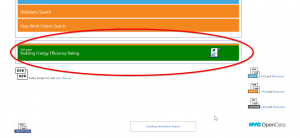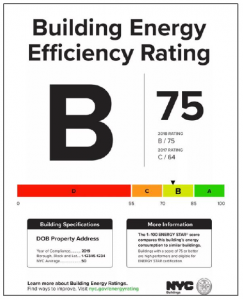NYC Building Owners: Here’s What You Need to Know About Local Law 33/95 Building Energy Grades
Local Law 33 is already an active New York City ordinance that requires buildings above 25,000 square feet to post an energy efficiency grade at each public entrance beginning in 2020. Labels must be posted at each public entrance of your building by October 31, 2020. Similar to the Department of Health grades for restaurants, a building’s energy efficiency grade will be a letter.
However, a subsequent ordinance (Local Law 95) changed the grade distribution. City grades are determined by a building’s ENERGY STAR® Portfolio Manager score, which comes from the annual energy benchmarking that is required under Local Law 84 and 133 (LL84/133).
Now that it’s time to post building energy grades, we wanted to share answers to some frequently asked questions.
How do I access my building’s energy grade? My Local Law 84/133 data was submitted earlier this year. Do I need to take action?
Now, all you need to do is access the Department of Buildings (DOB) NOW portal to download your grade and post it in a conspicuous location at each public entrance of your building by October 31, 2020.
To access the label in DOB NOW, enter the Borough-Block-Lot number for your property and print the label. You’ll find your label under the Building Energy Efficiency Rating. See below for a screenshot.

The label must be displayed either externally or internally in a conspicuous location near each public entrance, so it is visible to the public. While there are no horizontal restrictions, the label must be at a vertical height no less than four feet and no more than six feet from the ground or floor. The label must not be defaced, marred, camouflaged, or hidden from public view. The label must be displayed year-round and replaced each year with the latest issued version.
What does the building energy grade label look like?
Here is a sample grade label:

How are NYC energy grades determined?
City grades are determined by a building’s ENERGY STAR Portfolio Manager score, which comes from the annual energy benchmarking that is required under Local Law 84 and 133 (LL84/133). As an EnergyScoreCards subscriber, your LL84/133 energy benchmarking data was already submitted.
What’s the grade distribution?
A: 85 & above
B: 70-84
C: 55-69
D: 54 & below
F: Non-compliance
N: Exempt or score not feasible to obtain*
*Buildings with an N grade contain a data center, television studio, and/or a trading floor that is >10% Gross Floor Area (GFA) and are exempt from compliance. Some mixed-use buildings that do not meet Portfolio Manager’s requirements for a score and multifamily buildings with fewer than 20 units will also receive an N grade.
What happens if I don’t post my building’s energy grade?
Buildings that are required to comply will face an annual fine of $1,250 and a DOB violation if they do not post their building’s energy grade by October 31.
If you are not sure if you need to comply, check the NYC Benchmarking Law Covered Buildings List for the 2019 calendar year. If your building is listed, you need to comply.
How long do I need to keep my grade posted? How long do the grades last?
Grades must be posted year-round. Grades are updated every year based on your LL84/133 energy benchmarking data. Annually, you will need to follow this same process in October where you will access your building’s energy grade via the DOB NOW portal starting October 1 and will need to post the new grade by October 31.
I wasn’t a straight A student, but my building’s energy grade is making me blush. How can I improve my building’s energy grade?
For some, improving your grade may be as simple as ensuring your LL84/133 data is accurate. Is your square footage correct? What about the number of bedrooms and units? If that data is inaccurate, your ENERGY STAR Portfolio Manager score may be impacted, thus impacting your NYC building energy grade.
For others, look to your latest Local Law 87 (LL87) energy audit to see if there are any building improvements that could have a significant impact. If you have not had a comprehensive energy audit completed in some time, consider getting one soon. That audit will also help you plan how you will reduce your carbon emissions, which will impact your Local Law 97 (LL97)—the carbon emissions cap—path to compliance. You can read more about LL97 here and you can learn how LL87 can help you towards your LL97 plan here.
Regardless, it is important to remember that these grades correlate to ENERGY STAR Portfolio Manager scores, which are on a scale of 1 to 100 and represent how your building stacks up compared to all other buildings in Portfolio Manager. Thus, a score of 67 means that your building performs better than 67% of other buildings. It is also worth noting that an NYC energy grade of a D will encompass a wide variety of buildings performing up to a 54 Portfolio Manager score.
What kinds of grades can I expect to see across the city?
You should expect to see the full range of grades at buildings across the city. About 75% of covered buildings are expected to have a C or D grade. We expect these grades will shift as buildings start to put their plans to reduce emissions for LL97 compliance in place.
What about common amenity spaces, commercial spaces at multifamily buildings, and residential tenants’ energy consumption? Will they impact my building’s grade?
Yes. The ENERGY STAR Portfolio Manager score takes the whole building’s energy consumption into account. Thus, common amenity spaces and commercial spaces at multifamily buildings are factored into building energy grades and the same goes for residential tenants’ energy consumption in utility bills they pay themselves. We know that adds some complexity and may not fully represent all of the impactful energy-saving measures your building has put into place. If you’re worried that your large common amenity spaces are going to cost you a higher grade, it’s worth a larger discussion with an energy partner. If you’re concerned about commercial or residential tenants’ energy consumption, consider discussing this process with them. We’ve heard of property managers who are coming up with some innovative ways to encourage tenants of all kinds to reduce their energy consumption through friendly competition. It also wouldn’t hurt to share energy-saving tips with tenants in any high-traffic areas or via email.
For more information on the ordinance, see this blog or reach out to your dedicated Bright Power Energy Analyst.